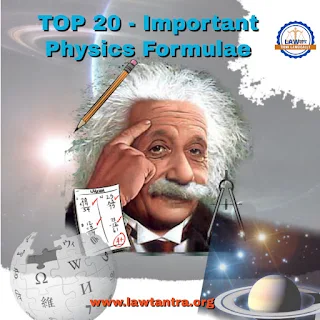- Ohm's Law - It states that the current passing through a conductor between two points is directly proportional to the potential difference across the two points provided the physical state and temperature etc. of the conductor does not change.
 | = | voltage |
 | = | current |
 | = | resistance |
- Pauli exclusion principle - It explains that no two electrons in the same atom or molecule can have the same set of quantum numbers.
 | = | probability amplitude that electron 1 is in the state a and electron 2 is in state b |
 | = | probability amplitude that electron 1 is in state a |
 | = | probability amplitude that electron 2 is in state b |
- Raman effect - It is the change in wavelength that occurs when light is scattered by the atoms or molecules in a transparent medium.
- Tyndall effect - The scattering of light by very small particles suspended in a gas or liquid.
- Boyles's Law - It states that temperature remaining constant, the volume of a given mass of a gas varies inversely with the pressure of the gas. Thus,
PV = K (constant), where, P = Pressure and V = Volume.
- Charles's Law - It states that pressure remaining constant, the volume of a given mass of gas increases or decreases by 1/273 part of its volume at 0-degree Celsius for each degree Celsius rise or fall of its temperature.
 | = | first volume |
 | = | second volume |
 | = | first temperature |
 | = | second temperature |
- Coulomb's Law - It states that force of attraction or repulsion between two charges is proportional to the amount of charge on both charges and inversely proportional to the square of the distance between them.
 | = | electric force |
 | = | Coulomb constant |
 | = | charges |
 | = | distance of separation |
- Heisenberg principle (uncertainty principle) - It is impossible to determine with accuracy both the position and the momentum of a particle such as an electron simultaneously.
 | = | uncertainty in position |
 | = | uncertainty of momentum |
 | = | Planck's constant |
 | = | pi |
- Archimede's principle - States that a body when wholly or partially immersed in a liquid experiences an upward thrust that is equal to the weight of the liquid displaced by it. Thus, the body appears to lose a part of its weight. This loss in weight is equal to the weight of the liquid displaced by the body.
 | = | buoyant force |
 | = | fluid density |
 | = | acceleration due to gravity |
 | = | fluid volume |
- Aufbau principle - It states that in an unexcited atom, electrons reside in the lowest energy orbitals available to them.
- Avogadro's Law - It states that equal volumes of all gases under similar conditions of temperature and pressure contain an equal number of molecules.
 | = | first volume |
 | = | second volume |
 | = | the first amount of gas (in moles) |
 | = | the second amount of gas (in moles) |
- Brownian motion - It is a zigzag, irregular motion exhibited by small solid particles when suspended in a liquid or gas due to irregular bombardment by the liquid or gas molecules.
- Bernoulli's principle - It states that as the speed of a moving fluid, liquid or gas, increases, the pressure within the fluid decreases. The aerodynamic lift on the wing of an airplane is also explained in part by this principle.
 | = | fluid density |
 | = | acceleration due to gravity |
 | = | pressure at elevation 1 |
 | = | velocity at elevation 1 |
 | = | height of elevation 1 |
 | = | pressure at elevation 2 |
 | = | velocity at elevation 2 |
 | = | height at elevation 2 |
- Gay-Lussac’s Law of combining volumes - Gases react together in volumes which bear simple whole-number ratios to one another and also to the volumes of the products, if gaseous — all the volumes being measured under similar conditions of temperature and pressure.
- Graham’s Law of Diffusion - It states that the rates of diffusion of gases are inversely proportional to the square roots of their densities under similar conditions of temperature and pressure.
- Kepler's Law - Each planet revolves around the Sun in an elliptical orbit with the Sun at one focus. The straight line joining the Sun and the planet sweeps out equal areas in equal intervals. The squares of the orbital periods of planets are proportional to the cubes of their mean distance from the Sun.
- Law of Floatation - For a body to float, the following conditions must be fulfilled: The weight of the body should be equal to the weight of the water displaced, and the center of gravity of the body and that of the liquid displaced should be in the same straight line.
- Law of conservation of energy - It states that energy can neither be created nor destroyed but can be transformed from one form to another. Since energy cannot be created or destroyed, the amount of energy present in the universe always remains constant.
 | = | initial kinetic energy |
 | = | initial potential energy |
 | = | final kinetic energy |
 | = | final potential energy |
- Newton's First Law of Motion - An object at rest tends to stay at rest, and an object in motion tends to stay in motion, with the same direction and speed in a straight line unless acted upon by some external force.
Some Useful Links:
▬▬▬▬▬▬▬▬▬▬▬▬▬▬▬▬▬▬▬▬
If any Photos/Videos/Article/Blog/Content has an issue with this upload, please contact us and we will remove it immediately. Contact E-Mail : lawtantra@gmail.com
▬▬▬▬▬▬▬▬▬▬▬▬▬▬▬▬▬▬▬▬






0 Comments
Please do not enter any spam link in the comment box.